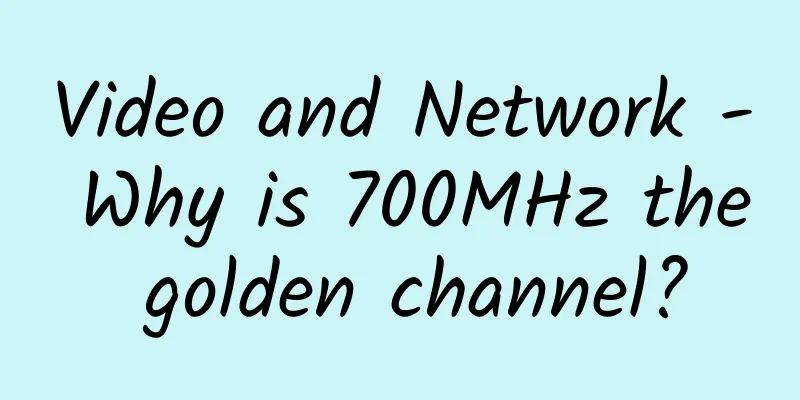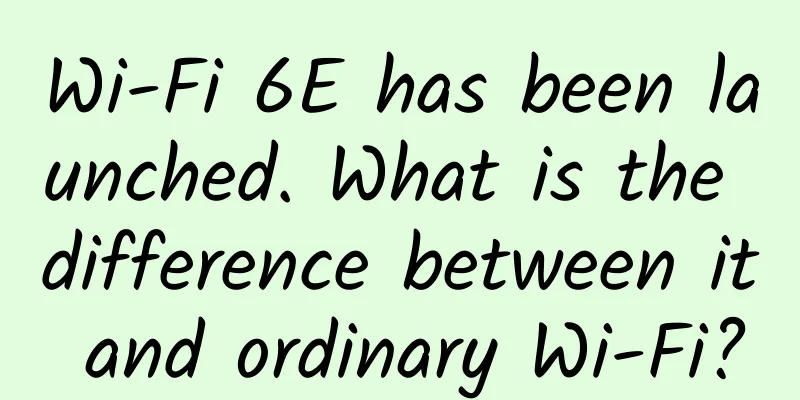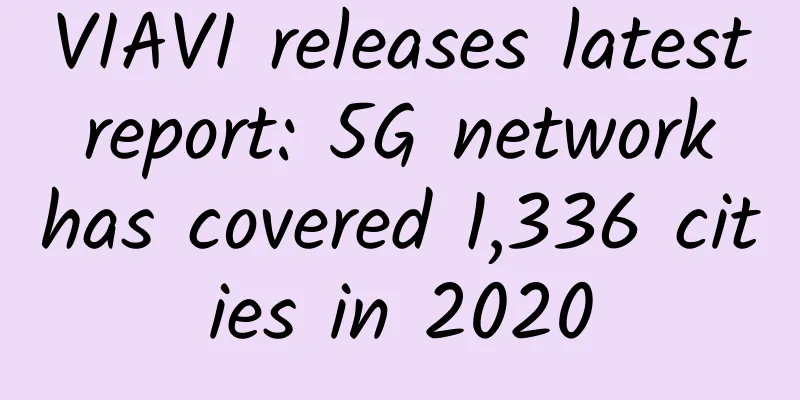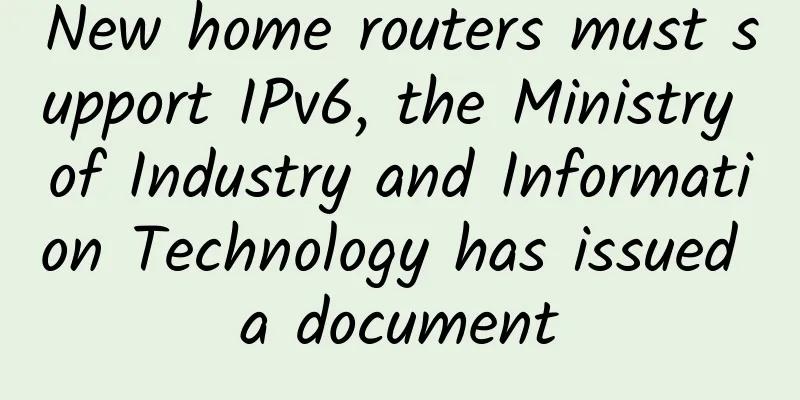Video and Network - Why is 700MHz the golden channel?

|
Labs Guide 700M is called the "golden frequency band" of mobile communications by some people. It has sparked many topics in the 4G era. Why is it so popular? China Radio and Television officially entered the market with 700M and became the fourth mobile operator. This article mainly introduces the standards and spectrum characteristics. The core is to talk about the benefits, background, current situation and disadvantages of 700M. In the future, we will also introduce the key technologies, construction plans, application scenarios, current situation of the industrial chain, and future trends of 700M.
1. Definition and standards of 700MHz 700MHz In the field of telecommunications, it refers to the radio wave spectrum resources located around 700M-800MHz. The global radio spectrum resources are allocated by the International Telecommunication Union (ITU) according to different radio transmission technologies and applications (as shown in Table 1). 700MHz is located in the UHF (300MHz-3000MHz) range. Due to its low frequency, wide coverage and strong penetration, it was the first to be widely used for broadcasting and television services in the world. However, with the development of digital TV technology and wireless communication technology, 700MHz has been gradually re-planned for mobile communication services where spectrum resources are even more scarce. Table 1 ITU radio band division 1.1 ITU's redefinition of 700MHz After 2000, digital terrestrial broadcasting technology has become mainstream in Europe, and some analog TV signal bands have been left vacant, resulting in low spectrum utilization. At the same time, the demand for mobile broadband services has grown rapidly with the popularity of smartphones, but there is a lack of sufficient spectrum support. In 2007, the ITU decided at the World Radiocommunication Conference WRC-07 to use the 698M - 806MHz frequency band, commonly known as the 700MHz frequency band, originally used for analog signals, for mobile communications. In 2015, the WRC-15 conference explicitly released part of the 700MHz spectrum resources originally used for radio and television services for mobile communications services in Europe, Africa, the Middle East and Central Asia. 1.2 3GPP standard definition of 700Mhz In Release 15, 3GPP defines 5G wireless (NR) spectrum as two spectrum ranges referred to as FR, FR1 and FR2. **FR1 refers to the lower frequency band 450M-6GHz, also known as Sub6G; FR2 refers to the higher frequency band such as 24.2GHz - 52.6GHz, which is the millimeter wave frequency band. **700MHz is defined as the n28 band in FR1, with 703MHz - 748MHz for uplink and 758MHz - 803MHz for downlink, using frequency division duplex (FDD) mode (as shown in Table 2). Table 2 3GPP defines FDD NR spectrum range 1.3 Development of 700MHz frequency band abroad The 700 MHz frequency band has excellent characteristics such as strong penetration and wide coverage. It is considered by the European Commission to be the best Internet access band that can cover Europe, even in rural and remote areas. It can also promote the efficient use of radio spectrum technology by radio and television, and is called the "digital dividend" [1]. In 2015, the European Commission issued a public consultation on the release of the 700MHz frequency band for mobile broadband, which was recognized by more than 60% of institutions. Then in 2016, the European Commission explicitly approved all EU member states to use the 700MHz frequency band for mobile services (especially future 5G services) and complete the 700MHz frequency clearance by 2020. In 2005, the Federal Communications Commission (FCC) of the United States passed the Digital Television Conversion and Public Safety Act, which stipulated that after completing the analog/digital conversion, the United States would release the 700MHz (698-806MHz) spectrum resources originally used for television channels and re-plan them for commercial services (84M) and public safety (24MHz). In 2008, the 84MHz frequency band was publicly auctioned to seven US telecommunications operators. 1.4 China’s new positioning for 5G 700M The 700MHz frequency band was first used in China for radio and television systems. my country's radio and television spectrum originally consisted of three 96MHz bandwidth segments, namely 470-566M, 606-702M, and 702-798M. Taking into account the global industrial development of the 700MHz frequency band and the progress of "analog-to-digital conversion" of domestic terrestrial television, in April 2020, the Ministry of Industry and Information Technology (MIIT) issued the "Notice on Adjusting the 700MHz Frequency Band Commodity Rate Use Plan", aiming to re-plan the spectrum resources of 700MHz (703-743/758-798MHz frequency band) originally used for radio and television services for 5G mobile communication systems, and use frequency division duplex (FDD) working mode. Subsequently, the State Administration of Radio, Film and Television immediately launched the nationwide 700MHz frequency clearance work for terrestrial digital television, and clarified that in areas where the central government, provinces, cities and counties have achieved digital broadcasting, from June 1, 2020 to March 31, 2021, terrestrial analog or digital television programs in this frequency band will be shut down. Radio and television stations in various regions have actively carried out the 700MHz frequency clearance work[2]. Since 2017, the Ministry of Industry and Information Technology has planned 3000-5000MHz 5G mid-band spectrum resources for 5G. At the same time, the Ministry of Industry and Information Technology has begun to study the planning of 5G high-band millimeter waves. The use of the 700MHz band for mobile communication systems provides valuable low-band spectrum resources for China's 5G development, which will help promote the coordinated development of 5G high, medium and low frequency bands. 2. 700M wireless spectrum characteristics As we all know, the physical characteristics of radio waves are that the lower the frequency, the smaller the propagation loss, the longer the coverage distance, and the stronger the diffraction ability, the better the indoor coverage of the building. Compared with the medium and high frequency bands of 5G (such as medium frequency 2.6 GHz or high frequency millimeter wave), the 700MHz frequency band has excellent characteristics such as strong penetration, wide coverage, and low transmission loss. It is suitable for large-scale network coverage, and FDD has low latency compared to TDD (time division duplex mode), which can enhance uplink and create high and low frequency three-dimensional network. In addition, 700MHz is supported by international standards, and the industrial chain is gradually maturing, which will reduce the cost of network construction for operators. The advantages and disadvantages of the 700MHz spectrum are introduced below. 2.1 Advantages of 700MHz Spectrum 2.1.1 Wide coverage, achieving continuous outdoor coverage 700MHz is a 5G low-frequency spectrum with the advantage of wide coverage. In rural and suburban environments, the coverage radius of 700MHz is twice that of 2.6G, 2.3 times that of 3.5G low-frequency band, nearly 3 times that of 4.9G, as shown in Table 3, and 16 times that of millimeter wave. The coverage area is 4-5 times that of 2.6G, nearly 10 times that of 4.9G, and 240 times that of millimeter wave. High-frequency millimeter wave has large path loss and is close to line-of-sight transmission. It is easily blocked by the body, walls, vegetation, and raindrops. The coverage range is only 100-300 meters, which is far from the coverage range of 700MHz. At present, China Mobile has built 3.15 million 4G base stations across the country, covering the whole country. However, if 700MHz is used, it is estimated that only 500,000 to 600,000 base stations are needed to cover the whole country. Using 700M as wireless network coverage in rural and remote areas can greatly reduce the cost of site construction, operation and maintenance, and power loss. The following table is a comparison of the calculation results based on 700M edge rate of 20M downlink and 5M uplink; 2.6G/3.5G/4.9G edge rate of 50M downlink and 5M uplink. Table 3 Comparison of spectrum coverage radius 2.1.2 Low propagation loss, achieving deep indoor coverage Compared with the 5G 2.6GHz band, 700MHz has low propagation loss, strong diffraction capability and indoor coverage, and can achieve deep coverage in ordinary buildings. 700M has 33.8dB lower propagation loss than millimeter wave, 15.4dB lower propagation loss than 2.6G, and 13dB lower propagation loss than 2.1G (as shown in Figure 1). In terms of wall penetration loss, 700M has 6dB lower loss than 2.6G (see Figure 1), 9dB lower than 3.5G, and 17dB higher deep coverage capability. Millimeter waves cannot even penetrate a piece of paper. In outdoor environments, the average signal strength of the 700MHz system is about 20dB stronger than the 2.6GHz system and 12dB stronger than the average 1800MHz signal. In areas where optical fiber is difficult to reach, 700MHz can give full play to its advantages of wide coverage and indoor coverage, and replace optical fiber access through customer premise equipment (CPE), thus opening up the "last mile" of the network in remote areas. 2.1.3 Low air interface delay Since 700MHz uses the frequency division duplex (FDD) mode with dual uplink and downlink channels (defined by 3GPP), and the mid-band uses the time division duplex (TDD) mode with single uplink and downlink channels, the FDD mode naturally has the advantage of low uplink and downlink network latency. According to tests, the one-way air interface latency of 700MHz is 2-4ms, which is only 30% - 60% of the mid-band network latency (as shown in Figure 2). Due to the high frequency and the use of large-scale antenna array technology, the air interface latency of millimeter waves is only 0.25ms - 0.125ms. The reduction in network latency will significantly improve the user experience of services such as video, and help realize high-reliability and low-latency (URLLC) services such as 5G industrial Internet and Internet of Vehicles. 2.1.4 Small Doppler frequency deviation and good mobile signal stability Compared with 4G, 5G uses medium and high frequency bands. **Since the 700MHz wavelength is longer, the Doppler frequency deviation is smaller when the moving speed is the same and the incident angle is the same, and the signal stability is better when moving at high speed. **For example, in mobile scenarios such as high-speed rail and highways, the 700MHz signal is more stable and reliable. Compared with millimeter waves, the millimeter wave beam is narrow, and objects can easily leave the beam area when moving. It is more difficult to provide signals for moving objects, and strong tracking capabilities and reconnection mechanisms are required. 2.2. Disadvantages of 700MHz spectrum Compared with 5G mid- and high-frequency bands, 700MHz has a low frequency and a long wavelength, and generally uses four antennas. It cannot support Massive MIMO large array antennas (64/128/256 antennas). Compared with 5G mid- and high-frequency bands, the uplink and downlink rates and network capacity are shortcomings. Low speed and capacity Compared with 2.6GHz or millimeter wave, 700MHz has lower peak rate and average throughput, as shown in Table 4. **The theoretical peak rate of 700MHz downlink is 350Mbps, which is 1/5 of the peak rate of 2.6GHz (64 antennas) and 1/11 of the peak rate of millimeter wave, **where the peak rate of millimeter wave is 4Gbps; the average user throughput of the cellular cell is 100-120Mbps downlink, which is 1/12 of the 2.6GHz network capacity, and 60Mbps uplink, which is 1/6 of the 2.6GHz network capacity. The peak rate and network capacity of 700MHz are limited. Table 4 Theoretical uplink and downlink peak rates of each frequency band We will have an in-depth discussion on 700M's key technologies, construction plans, application scenarios, current status of the industrial chain, and future trends, and continue to analyze and share. [This article is an original article by 51CTO columnist "Mobile Labs". Please contact the original author for reprinting.] Click here to read more articles by this author |
<<: How does HTTPS ensure secure transmission?
>>: CDN: What are edge CDN and virtual CDN (vCDN)?
Recommend
China Mobile's 5G planning goals have been clarified
At the online forum "How to 'accelerate&...
Exploration of CDN Technology Innovation and Business Model——2018 Asia Pacific CDN Summit was grandly held
[51CTO.com original article] On April 11-12, 2018...
How remote work is changing the future of network management
During the COVID-19 pandemic, businesses have und...
Ministry of Industry and Information Technology: Local governments should work harder on 5G applications
"Although various regions are now making gre...
Why enterprises should pay close attention to Wi-Fi 7
Industry experts predict that the latest Wi-Fi ve...
Unexpectedly, China Unicom is the biggest loser in number portability
It is said that China Mobile has announced that t...
TCP, it’s finally here!
[[394208]] Previous articles have been talking ab...
Hyper-converged data center network CloudFabric 3.0 builds a new data center network foundation
Recently, at the "ICT China High-level Forum...
FCC win clears way for massive Wi-Fi 6E upgrade
A ruling [PDF] made public on Tuesday by the U.S....
Competition in the fixed broadband market enters the "second half"
China Telecom leads strongly, China Mobile overta...
RAKsmart popular cloud server 10% off annual payment from 79 yuan, bare metal cloud/RAK Cloud/VPS 30% off, Hong Kong/Japan/Los Angeles/San Jose data center
RAKsmart also offers substantial discounts on var...
Riverbed Retail Digital Transformation Survey Results: The Next Three Years Will Be Critical for the Development of Physical Stores
The retail industry was born along with human civ...
How do packets and routing tables forward data in the network? Learn in one minute
1. Routing Table When the frame reaches the route...
CUBECLOUD VPS Hosting 12% off, Hong Kong CN2 GIA/Los Angeles CN2 GIA/AS4837 optional
CUBECLOUD has launched a promotional activity cal...
5G messaging reaches a new level, and the commercialization process is expected to accelerate
With the advancement of technology, the commercia...









